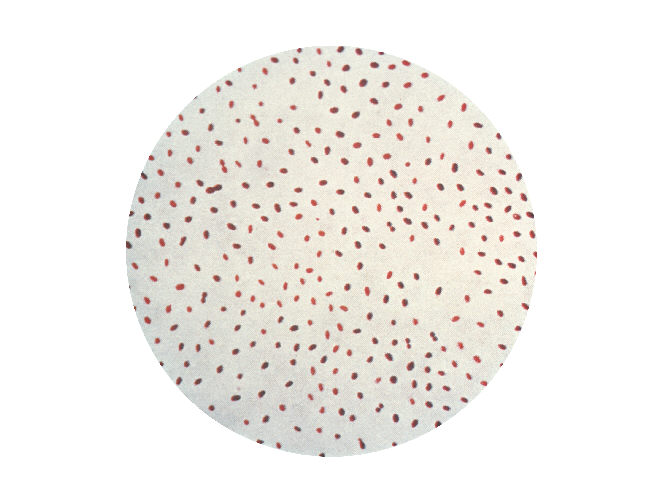- Brucella
Taxobox
color = lightgrey
name = "Brucella"

regnum = Bacteria
phylum =Proteobacteria
classis =Alpha Proteobacteria
ordo =Rhizobiales
familia =Brucellaceae
genus = "Brucella"
subdivision_ranks = Species
subdivision = "B. abortus" "B. canis" "B. melitensis" "B. neotomae" "B. ovis" "B. suis" "B. pinnipediae""Brucella" is a
genus ofGram-negative bacteria.cite book | author = Ryan KJ, Ray CG (editors) | title = Sherris Medical Microbiology | edition = 4th ed. | publisher = McGraw Hill | year = 2004 | isbn = 0-8385-8529-9 ] They are small (0.5 to 0.7 by 0.6 to 1.5 µm), non-motile , encapsulated coccobacilli."Brucella" is the cause of
brucellosis , a true zoonotic disease (i.e. human-to-human transmission has not been identified). It is transmitted by ingesting infected food, direct contact with an infected animal, or inhalation of aerosols. Minimum infectious exposure is between 10 - 100 organisms.Brucellosis primarily occurs through occupational exposure (e.g. exposure to cattle, sheep, pigs), but also by consumption of unpasteurised milk products.There are a few different species of "Brucella", each with slightly different host specificity. "B. melitensis" which infects
goat s andsheep , "B. abortus" which infectscow s, "B. suis" infectspig s, "B. ovis" infectssheep s and "B. neotomae". Recently a new species was discovered in marine mammals: "B. pinnipediae".Diagnosis
"Brucella" is isolated from a
blood culture on Castenada medium. Prolonged incubation (up to 6 weeks) may be required as they're slow-growing, but on modern automated machines the cultures often show positive results within seven days. OnGram stain they appear as dense clumps of Gram-negative coccobacilli and are exceedingly difficult to see.It's crucial to be able to differentiate "Brucella" from "
Salmonella " which could also be isolated fromblood culture s and are Gram negative. Testing forurease would successfully accomplish the task; as it is positive for the former and negative for the latter."Brucella" could also be seen in
Bone marrow .Laboratory acquired brucellosis is common.cite journal |author=Robichaud S, Libman M, Behr M, Rubin E |title=Prevention of laboratory-acquired brucellosis |journal=Clin. Infect. Dis. |volume=38 |issue=12 |pages=e119–22 |year=2004 |pmid=15227634 |doi=10.1086/421024] This most often happens when the disease is not thought of until cultures become positive, by which time the specimens have already been handled by a number of laboratory staff. The idea of preventative treatment is to stop people who have been exposed to "Brucella" from becoming unwell with the disease.
There are no clinical trials to be relied on as a guide for optimal treatment, but a three week course of
rifampicin anddoxycycline twice daily is the combination most often used, and appears to be efficacious;cite journal |author=Maley MW, Kociuba K, Chan RC |title=Prevention of laboratory-acquired brucellosis: significant side effects of prophylaxis |journal=Clin. Infect. Dis. |volume=42 |issue=3 |pages=433–4 |year=2006 |pmid=16392095 |doi=10.1086/499112] the advantage of this regimen is that it is oral medication and there are no injections, however, a high rate of side effects (nausea, vomiting, loss of appetite) has also been reported.Human Brucellosis
Sir David Bruce isolated "B. melitensis" from British soldiers who died from Malta fever in
Malta . The disease is characterized by acute undulating fever, headache, night sweats, fatigue and anorexia. Human Brucellosis is not considered a contagious disease and people become infected by contact with fluids from infected animals (sheep, cows or pigs) or derived food products like unpasteurized milk and cheese. Brucellosis is also considered an occupational disease because has higher incidence in people working with animals (slaughterhouse cases). The real worldwide incidence of Brucellosis is unknown because there is a low level of surveillance and report in brucella-endemic areas.Blue light study
In a study published in "Science" magazine in August 2007, it was revealed that "Brucella" reacts strongly to the presence of the blue spectrum in natural light, reproducing at a great rate and becoming infectious. Conversely, depriving "Brucella" of the blue wavelengths dropped its reproductive rate by 90%, a result one of the co-authors called "spectacular." [http://sciencenow.sciencemag.org/cgi/content/full/2007/823/2 "Deadly in the Daylight"] August 23, 2007 in "ScienceNOW Daily News". Accessed September 8, 2007.] [http://www.sciencemag.org/cgi/content/abstract/317/5841/1090 "Blue-Light-Activated Histidine Kinases: Two-Component Sensors in Bacteria"] , August 24 2007, "Science" Vol. 317:5841, pp. 1090 - 1093 Accessed September 8, 2007.]
References
External links
* [http://patric.vbi.vt.edu/organism/overview.php?organismId=1 Brucella] (from [http://patric.vbi.vt.edu/ PATRIC] the PathoSystems Resource Integration Center, a [http://www3.niaid.nih.gov/ NIAID] Bioinformatics Resource Center)
* [http://www.hpa.org.uk/webw/HPAweb&Page&HPAwebAutoListName/Page/1191942172786?p=1191942172786 Brucellosis]
* [http://www.genomesonline.org/search.cgi?colcol=all&goldstamp=ALL&gen_type=ALL&org_name1=genus&gensp=Brucella&org_domain=ALL&org_status=ALL&size2=ALL&org_size=Kb&gen_gc=ALL&phylogeny2=ALL&gen_institution=ALL&gen_funding=ALL&gen_data=ALL&cont=ALL&gen_country=ALL&gen_pheno=ALL&gen_eco=ALL&gen_disease=ALL&gen_relevance=ALL&gen_avail=ALL&selection=submit+search Brucella Genome Projects] (from [http://www.genomesonline.org Genomes OnLine Database] )
* [http://img.jgi.doe.gov/cgi-bin/pub/main.cgi?section=TaxonList&page=lineageMicrobes&genus=Brucella Comparative Analysis of Brucella Genomes] (at DOE's IMG system)
* [http://bbp.hegroup.org/ Brucella Bioinformatics Portal]
Wikimedia Foundation. 2010.
